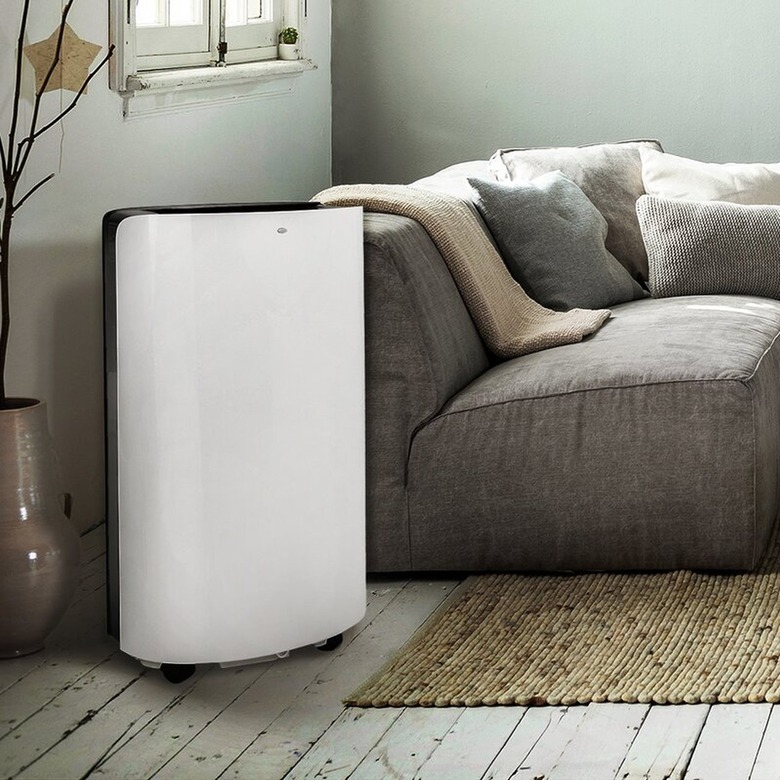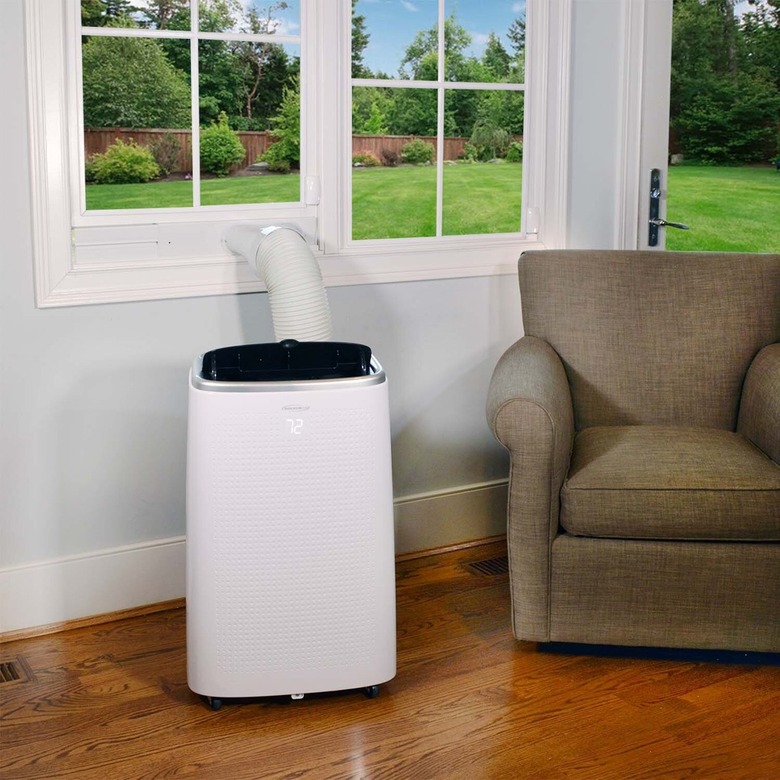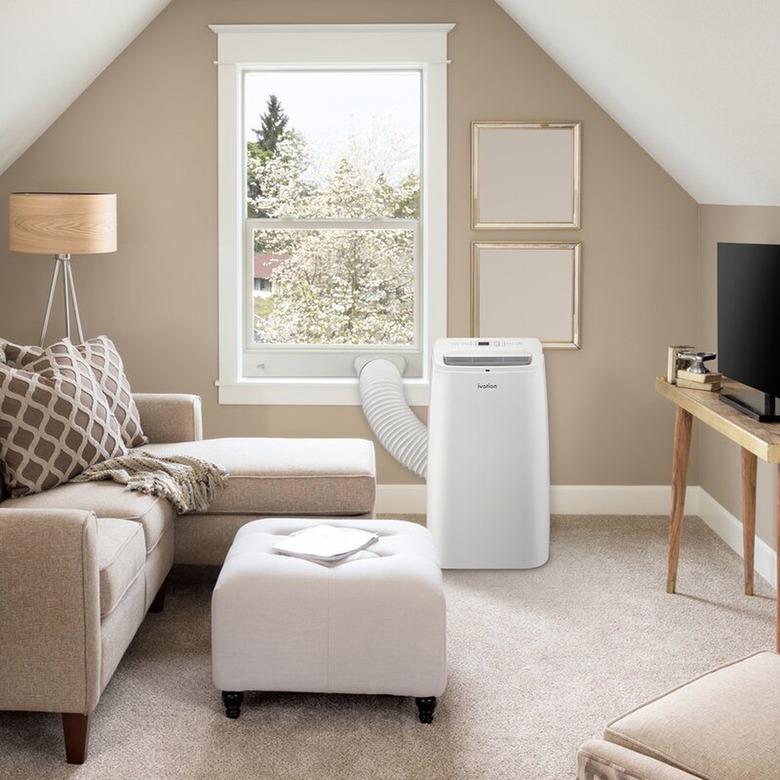Choosing A Portable Air Conditioner — A Buying Guide
We may receive a commission on purchases made from links.
While a portable air conditioner isn't necessarily as portable as you might expect, it's still a handy device that can meet the needs of people without central air conditioning — and even homeowners who do have a central HVAC system can benefit from owning one. By cooling target areas instead of the whole house, a portable air conditioner allows you to switch off the main system, save energy, and still stay cool when you spend most of your time in a particular part of your home.
You can even move it around when your activities bring you to another part of the house, although that might not be as easy as advertised. A portable air conditioner can be heavy — from 50 to 75 pounds — and it has to be near a window so the exhaust hose can be routed outside. On top of that, some models handle condensate, which is an inevitable byproduct of air conditioning, by draining it into a bucket that you have to empty manually.
Despite these drawbacks, there are good reasons for choosing a portable air conditioner. For one, it works with any type of window, although like a window air conditioner, it works best with double-hung windows with a vertical sliding sash. It costs about as much as a window air conditioner, and although it's slightly less energy efficient, it makes about the same amount of noise. If you live in a community that regulates the use of window air conditioners because of their visual impact, it's probably your best low-cost cooling option.
Interested in buying a portable A/C unit? Here's what you need to know before you start perusing online.
What Is a Portable Air Conditioner?
What Is a Portable Air Conditioner?
A portable air conditioner is basically a window unit installed in a standalone housing with wheels, and it works the same way. A compressor pumps refrigerant through a condenser coil, pressurizing it and turning it into a liquid, which releases heat that has to be exhausted from the machine. The refrigerant passes through an expansion valve into an evaporator coil, where it vaporizes and draws heat from the surrounding air, and a blower circulates the cool air throughout the room.
It would be counterproductive to release the hot exhaust air back into the room, so a portable air conditioner comes with an exhaust hose and a window insert for creating a vent opening. Some units even come with an extra hose that allows the machine to draw air from outdoors rather than from the room, and these include a double-vent window insert. An air conditioner wouldn't be portable if it had to be hardwired, so all but the largest commercial units plug into a conventional wall outlet.
When you need to move the machine to another room, you remove the insert and transfer it to another window and then roll the machine to the new location. Some units are heavy, and if you need to move them up or down stairs, you may need help. Once the vent insert has been installed and you have the air conditioner where you need it, hook up the hose or hoses, plug it in, and enjoy the cool air.
Single-Hose vs. Dual-Hose Units
Single-Hose vs. Dual-Hose Units
The least expensive portable air conditioners, which start at around $285, have a single vent hose to exhaust hot air from the compressor. These units have to circulate room air past the cooling coil, and as that air gets vented outdoors, negative pressure is created in the room. The negative pressure can pull in hot outdoor air through gaps in doors and walls, and this limits the cooling efficiency of the unit and its ability to cool large rooms.
More expensive units have an extra hose that draws air from outdoors, eliminating the negative pressure problem. Besides cooling large rooms more completely, a dual-hose unit cools faster and more efficiently. Dual-hose units also have a price tag ranging upward from $550. In general, a single-hose unit can cool a room up to 425 square feet, while a dual-hose portable air conditioner can handle up to 525 square feet, but dual-hose units need extra power to accomplish this (1,250 vs. 1,200 watts), which adds slightly more to your energy bill.
Condensate Drainage Options
Condensate Drainage Options
When warm air circulates around the cooling coils, moisture condenses onto the coil. A window A/C unit or central air system can drain this water outside, but this option isn't available for portable air conditioners. The easiest solution is to allow the water to drip into a bucket (which has to be emptied manually), or the system includes a drain pan that can be hooked up to a garden hose that you route outside, like some Honeywell units feature.
Some manufacturers, such as Whynter, have a more convenient solution and provide units that vaporize the condensate and expel it through the exhaust hose. These fully evaporative models tend to cost more, but the convenience is worth it. All air conditioners also dehumidify, but many portable air conditioners are designed to work in dehumidifier mode without cooling, and if you have one of these, you'll particularly appreciate the fact that you don't have to worry about where all the water is going.
Portable Air Conditioner Cooling Capacity
Portable Air Conditioner Cooling Capacity
Air conditioning is a form of heat exchange, and cooling capacity is measured in what's called British Thermal Units (BTU). It's important to select a unit with enough cooling capacity for the area of the room you're cooling, but you don't want to overdo it. A unit that's too large for the room will cycle on and off frequently, and since air conditioners draw more power when they switch on than they do when they're running, your operating costs will be unnecessarily high.
The rule of thumb is that 20 BTU of cooling power is needed per square foot, and in general, you need a 7,000- to 10,000-BTU portable air conditioner to cool a 300-square-foot room. If your room is larger than this but no larger than 700 square feet, go for an 11,000- to 14,000-BTU unit. If you're looking to cool an area larger than this — perhaps the entire ground floor of an open-floor-plan home — you may need a larger, commercial-grade unit, especially if part of the area you're cooling is a kitchen, which needs an extra 4,000 BTU of cooling capacity.
Installing a Portable Air Conditioner
Installing a Portable Air Conditioner
Although a portable air conditioner features easy installation — even easier than a window air conditioner — it does require some effort to prepare the window for the exhaust and intake hoses. The effort is minimal if you're using a double-hung window for exhaust because most units come with adjustable inserts that fit them.
To install, open the window, adjust the insert to fit the width of the frame, install it with the supplied fasteners, close the window flush with the top of the insert, and you're finished. If an insert isn't supplied with your unit, you can buy an insert online.
It's also possible to purchase inserts for horizontal sliding windows and for sliding patio doors, but none will fit casement windows, which are the type that crank open and closed. If this is the type of window you have, you may have to fashion your own insert using plywood or Plexiglas.
Once you determine where your vent opening will be, you simply clamp one end of the vent hose onto the back of the unit and the other end to the vent opening. If you have a dual-hose unit, you install both hoses the same way. Portable A/C units that drain through a garden hose also need a smaller opening for the hose, and you may have to drill this through the insert — if there isn't one already — or through the door or wall.
Best Portable Air Conditioner Features
Best Portable Air Conditioner Features
Not sure what to look for when shopping for a portable A/C? The best units also function in dehumidifier mode, and some have heating elements, so they can be used to keep you warm and dry during the winter when the house is sealed. These features, available on some models from Frigidaire, Black + Decker, and other manufacturers, are especially useful in basements, where heating and dehumidifying are often necessary.
Like window units, portable air conditioners make noise, and because the compressors that make the noise are inside the room (unlike window air conditioners, which have the noisier parts sitting outside), the noise tends to be more noticeable. The noise level of most units is between 51 and 54 dB, which is roughly equivalent to the sound of a conversation, but if noise is a concern, choose the quietest model you can find. You'll also want a remote control, and if you want to connect to a home assistant, such as Amazon Alexa, choose a model that features Wi-Fi connectivity.
The most efficient portable air conditioner features variable fan speeds and a programmable thermostat so you can lower your energy bill by programming the unit to run in energy-saving mode during times when you don't need it to operate at full capacity. It also functions as an air purifier by employing a combination of a pre-filter to remove particulates (which you need to change periodically) and an activated carbon or silver-ion filter to deodorize. If your unit has only a pre-filter, you can improve filtration by using an antimicrobial high-airflow filter instead of a conventional one.
Should I Choose a Window or Portable A/C Unit?
Should I Choose a Window or Portable A/C Unit?
Window air conditioners tend to run more efficiently than even the best portable air conditioning units, and once installed, they are less hassle. They seldom need more maintenance than a regular filter change and an occasional cleaning, and they don't take up valuable floor space. There is that small issue, however, of the unsightly compressor housing hanging out the window that drips water on the siding, sometimes even staining it. Some homeowners' associations ban them for this reason and for the fact that they can fall, although if installation includes a support bracket, this is unlikely.
The big advantage of portable air conditioners, however, is their flexibility. Even though it may take a little effort, you can move one from room to room. Sleek designs help offset the fact that portable air conditioners take up space that could otherwise be occupied by furniture, and the added functionality of heating and dehumidifying is a nice touch, although this capability is also available with some window units. Because of its flexibility, a portable air conditioner is an ideal choice to supplement a central air system that doesn't keep you quite cool enough.
References
- Compact Appliance: The Ultimate Guide to Buying a Portable Air Conditioner
- Consumer Reports: Air Conditioner Buying Guide
- Elite Plumbing, Heating & Air Conditioning: Single-Hose vs. Dual-Hose Air Conditioners
- Sylvane: Frequently Asked Questions About Portable Air Conditioners
- Sylvane: 5 Things to Consider When Buying a Portable Air Conditioner
- Compact Appliance: Portable Air Conditioners vs. Window Air Conditioners


